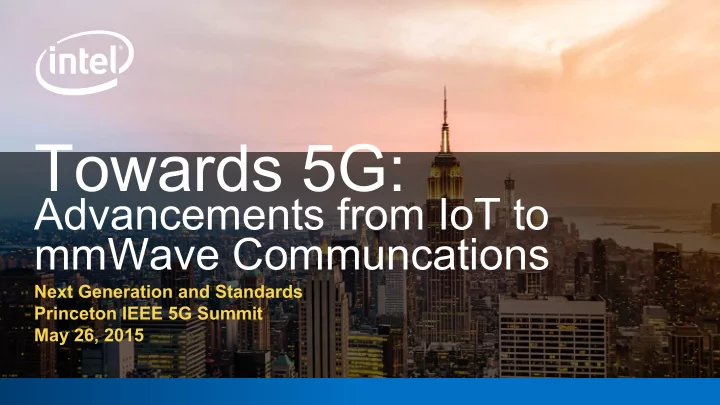

Towards 5G: Advancements from IoT to mmWave Communcations Next Generation and Standards Princeton IEEE 5G Summit May 26, 2015
5G requirements and challenges • Long range, small • 1000x network data, energy capacity efficient • 10x higher data rate, • Massive number of 5x lower latency Mobile Internet of devices Broadband Things Mission New Critical spectrum - • 100x higher data rate • Industrial and Applications mmWave • Opportunistic access vehicular • D2D/Ad-Hoc applications networks • Highly robust, reliable, responsive 2
5G Radio and Key Enabling Technologies/Trends 5G Key mm-Wave (mmWave) Radio cm-Wave (cmWave) Sub-6 GHz > 30 GHz 6 – 30 GHz LTE Evolution, 10’s MHz, >500 MHz, Hybrid MIMO CA, MIMO >100 MHz, MIMO Beamforming Technologies/Trends Advanced MIMO Inter-RAT tight D2D/Underlay and Beamforming interworking networks 5G Key New numerology, Network protocols and Flexible 5G RAT transformation access schemes air interface and extension to for IoT edge and devices 3
Advanced MIMO/beamforming Lower frequency Higher frequency bands bands Beam aggregation to increase cell-edge data rate Adaptive 3D beamforming towards target users • Transmit and receive beamforming operation for both control and data Multi-site coordinated channels transmission enabling • Combination of analog and digital cell-less network architecture beamforming at both access point and user terminal 4
Inter-RAT tight interworking Tight coupling of LTE and 5G RAT to ensure smooth deployment migration, efficient traffic offloading over opportunistic radio links and seamless mobility across 5G small cells ▪ LTE serves as fallback link when 5G RAT experiences blockage (for high frequencies) ▪ Control plane anchored at coverage layer ▪ Different levels of user plane coupling envisioned: Intra-RAT and inter-RAT fast and robust mobility handling and RLF recovery is essential especially in higher frequency spectrum 5
D2D/Underlay Networks Utilization of D2D connections for relay, local traffic offloading and aggregation to improve coverage, energy efficiency, robustness Enhanced D2D transmission with MIMO-BF at higher frequency bands to improve spatial reuse and spectral efficiency Network densification with self-backhauling to extend coverage for high data rates, improve capacity, and reduce channel blockage 6
5G IoT Massive IoT ▪ 10 6 -10 7 connections per km 2 , 10 years+ battery life ▪ Small subcarrier spacing and long TTI ▪ Non-orthogonal multiplexing to support ultra-high number of connections ▪ Lightweight and connectionless protocols to reduce signaling overhead Mission critical IoT ▪ Packet loss ~10 -9 , end-to-end latency ~1 ms ▪ Large subcarrier spacing and short TTI ▪ Exploiting frequency diversity/robust coding schemes to improve reliability ▪ Low latency uplink access and transmission (contention or carrier sensing based shared data channel) Intel Confidential – Do Not Forward 7
Putting things together: Flexible 5G RAT frame structure Mission critical IoT Massive IoT Mobile Broadban d Control and data TDM/FDM multiplexed Unified design for TDD/FDD Long TTI and short TTI support 8
9
Extending the Cloud to the Edge and Devices • To meet the content distribution and processing requirements, the cloud is moved to the edge • A powerful device can also become a networking node itself to meet especially requirements for IoT Remote Cloud Sensing/ Basic Terminal Proximity Services 5G is about communications + computing and involves both network nodes and devices 10
5G Vision: A New Era of Mobile Computing & Connectivity CLOUD AND SMART DATACENTE DEVICE S R NETWOR K 0101010101010101010101010101 010101010101010101010101011 INFRAST RUCTUR E Workloads Will be Shared & Coordinated: Smart Packet Processing, Network Offload, Data Analysis 5G Technologies Focus on the System, Instead of the Air Interface Alone 1 1
5G Innovation – Network Multi-Radio Access Technology Virtualized Heterogeneous Network 5G Small Cell or Macro-Cell Remote Radio Head cm & mm-Wave Arrays 500MHz+ Bandwidth Virtual core network (VNC) Multi-RAT: LTE (FDD/TDD), HSPA+, 5G Multiband µ-wave array LTE Rel-15, WiFi 802.11ax Internet Mobile device of 2020 IoT Device of 2020 Performance device – 10Gbps+ 12
5G Innovation – Device Ultra High Speed Inter-Processor Comms Multiple RATs Multi-band Support PHY processing GSM/EDGE Multi- Antenna Operation WCDMA Rel-15 FEM BT 5.x Comms Low frequency Auto Interference Core RF RF (<6GHz) Application GNSS Suppression (AIS) Proc Cores LTE Rel-15 mm-wave Locatio n cm– and mm-wave DS Core WiFi – 802.11ax FEM P antennas WiGig – 802.11 ad+ Senso “5G” rs RF Integration Media Cores Baseband Integration 4G-5G Transition Impact Advanced Baseband Signal Processing High Medium Low 13
Evolution of Wireless and Semiconductor Technologies Strained Silicon Hi-K Metal Gate 3D Transistors 90nm 65nm 45nm 32nm 22nm 14nm 10nm 7nm (Y2004) (Y2014) Mobile Internet has been riding on Moore’s Law 3B Transistors/IC and will continue to do in the 5G era 300M Transistors/IC 5M 3G Transistors/IC (10 Kbps) (2 Mbps) (300 Mbps) 1994 2004 2014 14
Recommend
More recommend